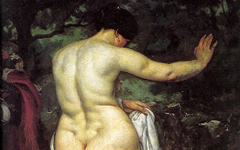Courbet’s The Stonebreakers (1849)
Michael Fried argued in 1992 that some of the figures painted by Courbet were not just what they seemed but were surrogates for the artist in the act of painting. Fried’s theory, like all leaps of imagination, was difficult to substantiate but the examples on this site from every century of Western art since the Renaissance support it. Fried noted that the workmen in Courbet’s early masterpiece, The Stonebreakers, appear strangely close to the surface (below). This impression is enhanced by the shadows of the men which are not ‘realistic’ but appear as though projected on a nearby wall.
Fried proposed that: ‘the figures of the old stonebreaker and his young counterpart may be seen as representing the painter-beholder’s right and left hands respectively: the first wielding a shafted implement that bears a distant analogy to a paintbrush or palette knife, the second supporting a roundish object that might be likened to the.....burden of a palette.’1 He further observed that the posture of the workmen, bent (courbé in French) under their grueling labor, puns on the artist’s name.2
Click next thumbnail to continue
We can add, though, that if the men are ‘artists’ at work with ‘brush’ and ‘palette’ then the shallow-looking landscape is like a canvas, an interpretation that explains the elongated shadows and why the figures appear so close to the surface. The background is not a real landscape but an upright painted landscape onto which the workers’ shadows are projected. As artists, they have fused their work in the studio with the subject of the painting. They are en plein air and in a studio.
Fried has also suggested that the large nude in Courbet's Source (left) again substitutes for the artist in front of his canvas, her left arm in a position to hold a palette, the other ‘painting’ the wood. Fried's argument would have been stronger had he compared the nude’s pose to Courbet’s own in a photograph taken a year or so earlier.
Click next thumbnail to continue

Left: Etienne Carjat, Courbet painting in his studio (c. 1866-7)
Right: Courbet, The Source (1868)
Click image to enlarge.
The sloping torso, turned head and upper left arm of each figure are equivalent. The legs, though switched, are in the same position. The right one has become the left and vice versa. It is even possible that Courbet used this photograph to pose the model because Fried was wrong to argue that the correspondence was unconscious.
See conclusion below
The regular user will recognize that Fried's observations match the proposals made on this site: that poetic artists have often used tools as metaphors for a paintbrush, from swords and spears to spades and spoons. Circular objects are turned into palettes and long, thin poles become mahlsticks. What Fried sees as peculiar to Courbet is common to art.
Lastly, in choosing a female nude, the iconic subject of nineteenth-century French art, to pose as his alter ego, Courbet not only conveys the androgyny of his mind (male and female) but a cardinal principle of poetic art as well: that artist and model are two sides of the same self. It is his underlying message in The Lovers too.
More Works by Courbet
Michael Fried read this painting exactly as we would 20 years ago

Courbet’s The Wheat Sifters (1854-5)
Notes:
1. Fried, Manet’s Modernism (Chicago and London: The University of Chicago Press) 1992, pp. 105-6; see also Linda Nochlin, Gustave Courbet: A Study of Style and Society (New York: Garland, Outstanding Dissertation in the Fine Arts) 1976, pp. 149-50, cited in Fried, ibid., note 29, p. 314.
2. Fried, ibid, p. 150
Original Publication Date on EPPH: 07 Nov 2010. | Updated: 0. © Simon Abrahams. Articles on this site are the copyright of Simon Abrahams. To use copyrighted material in print or other media for purposes beyond 'fair use', you must obtain permission from the copyright owner. Websites may link to this page without permission (please do) but may not reproduce the material on their own site without crediting Simon Abrahams and EPPH.





